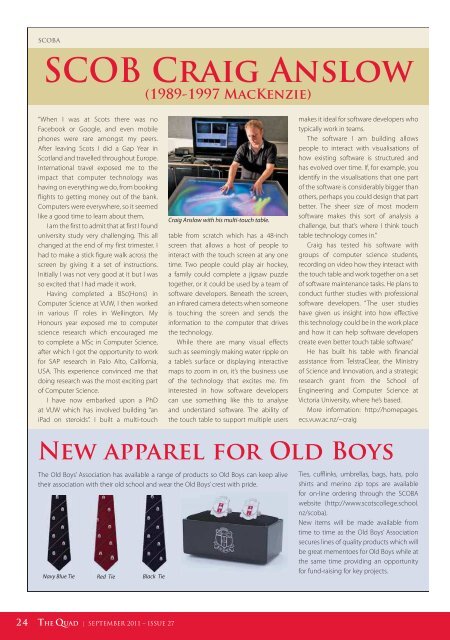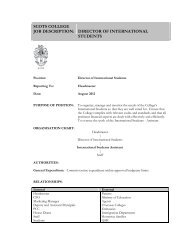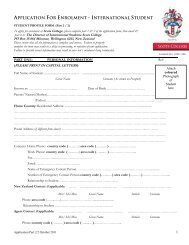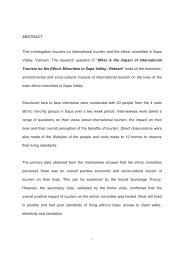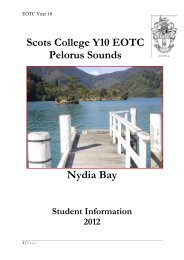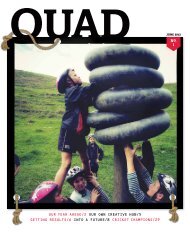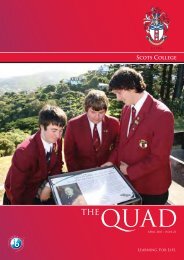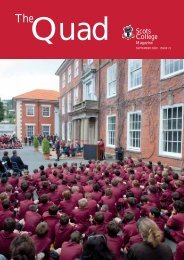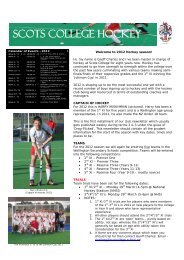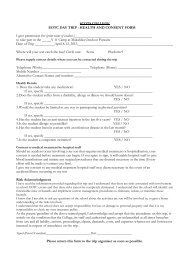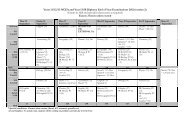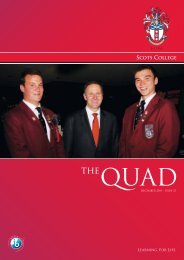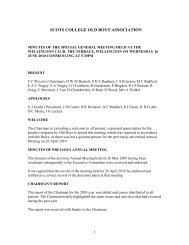Issue 27 - Sept 2011 - Scots College
Issue 27 - Sept 2011 - Scots College
Issue 27 - Sept 2011 - Scots College
You also want an ePaper? Increase the reach of your titles
YUMPU automatically turns print PDFs into web optimized ePapers that Google loves.
SCOBA<br />
SCOB Craig Anslow<br />
(1989-1997 MacKenzie)<br />
“When I was at <strong>Scots</strong> there was no<br />
Facebook or Google, and even mobile<br />
phones were rare amongst my peers.<br />
After leaving <strong>Scots</strong> I did a Gap Year in<br />
Scotland and travelled throughout Europe.<br />
International travel exposed me to the<br />
impact that computer technology was<br />
having on everything we do, from booking<br />
flights to getting money out of the bank.<br />
Computers were everywhere, so it seemed<br />
like a good time to learn about them.<br />
I am the first to admit that at first I found<br />
university study very challenging. This all<br />
changed at the end of my first trimester. I<br />
had to make a stick figure walk across the<br />
screen by giving it a set of instructions.<br />
Initially I was not very good at it but I was<br />
so excited that I had made it work.<br />
Having completed a BSc(Hons) in<br />
Computer Science at VUW, I then worked<br />
in various IT roles in Wellington. My<br />
Honours year exposed me to computer<br />
science research which encouraged me<br />
to complete a MSc in Computer Science,<br />
after which I got the opportunity to work<br />
for SAP research in Palo Alto, California,<br />
USA. This experience convinced me that<br />
doing research was the most exciting part<br />
of Computer Science.<br />
I have now embarked upon a PhD<br />
at VUW which has involved building “an<br />
iPad on steroids”. I built a multi-touch<br />
Craig Anslow with his multi-touch table.<br />
table from scratch which has a 48-inch<br />
screen that allows a host of people to<br />
interact with the touch screen at any one<br />
time. Two people could play air hockey,<br />
a family could complete a jigsaw puzzle<br />
together, or it could be used by a team of<br />
software developers. Beneath the screen,<br />
an infrared camera detects when someone<br />
is touching the screen and sends the<br />
information to the computer that drives<br />
the technology.<br />
While there are many visual effects<br />
such as seemingly making water ripple on<br />
a table’s surface or displaying interactive<br />
maps to zoom in on, it’s the business use<br />
of the technology that excites me. I’m<br />
interested in how software developers<br />
can use something like this to analyse<br />
and understand software. The ability of<br />
the touch table to support multiple users<br />
makes it ideal for software developers who<br />
typically work in teams.<br />
The software I am building allows<br />
people to interact with visualisations of<br />
how existing software is structured and<br />
has evolved over time. If, for example, you<br />
identify in the visualisations that one part<br />
of the software is considerably bigger than<br />
others, perhaps you could design that part<br />
better. The sheer size of most modern<br />
software makes this sort of analysis a<br />
challenge, but that’s where I think touch<br />
table technology comes in.”<br />
Craig has tested his software with<br />
groups of computer science students,<br />
recording on video how they interact with<br />
the touch table and work together on a set<br />
of software maintenance tasks. He plans to<br />
conduct further studies with professional<br />
software developers. “The user studies<br />
have given us insight into how effective<br />
this technology could be in the work place<br />
and how it can help software developers<br />
create even better touch table software.”<br />
He has built his table with financial<br />
assistance from TelstraClear, the Ministry<br />
of Science and Innovation, and a strategic<br />
research grant from the School of<br />
Engineering and Computer Science at<br />
Victoria University, where he’s based.<br />
More information: http://homepages.<br />
ecs.vuw.ac.nz/~craig<br />
New apparel for Old Boys<br />
The Old Boys’ Association has available a range of products so Old Boys can keep alive<br />
their association with their old school and wear the Old Boys’ crest with pride.<br />
Navy Blue Tie<br />
Red Tie<br />
Black Tie<br />
Ties, cufflinks, umbrellas, bags, hats, polo<br />
shirts and merino zip tops are available<br />
for on-line ordering through the SCOBA<br />
website (http://www.scotscollege.school.<br />
nz/scoba).<br />
New items will be made available from<br />
time to time as the Old Boys’ Association<br />
secures lines of quality products which will<br />
be great mementoes for Old Boys while at<br />
the same time providing an opportunity<br />
for fund-raising for key projects.<br />
<strong>Scots</strong> <strong>College</strong> Old Boys’ Visits<br />
An increasing number of Old Boys are reconnecting with their old <strong>College</strong>. They come for many reasons – some<br />
to view the impressive building projects scheduled to be open soon, some to revisit happy school day memories.<br />
Many have not been back since they left school. This year our SCOB visitors included…<br />
SCOB Rev Michael [John]<br />
Holland [1958 – 1962]<br />
currently Chaplain, St Mark’s<br />
School in Wellington visited<br />
the <strong>College</strong> in May. Michael<br />
attended the <strong>College</strong> as a<br />
Day Boy in Glasgow House.<br />
He played Soccer (his 1962<br />
team was undefeated all season!) and he remembers fondly his<br />
participation in the drama production ‘Murder in the Cathedral’.<br />
Bruce Leiataua [1980 – 1990] visited in June, and who is currently<br />
living and working in American Samoa. Bruce visits New Zealand<br />
twice a year and is looking to enrol his 10 year old son at <strong>Scots</strong> for<br />
his secondary education.<br />
Senior SCOB Phillip [Phil] Nissen Bustin [1937 – 1949]<br />
Phil made his first visit to his old <strong>College</strong> in June since 2001.<br />
Accompanied by his daughter, Ruth Gould, and his two grandsons,<br />
David and Leonard Gould, he was brought over from Melbourne<br />
specifically to see <strong>Scots</strong> again and to revisit special places of his<br />
early life in Wellington including his family home.<br />
Phil entered as a boarder in 1940 when his older brother Cyril<br />
Nissen Bustin was leaving <strong>Scots</strong>. There was no-one to take him<br />
home after school so he became a boarder! During his visit Phil<br />
commented on his gratitude to the Matron of the day who went<br />
out of her way to ensure her young boarding charges were happy.<br />
Phil was a Prefect; 1 st XV 1948, 1949; Runner-Up Senior Athletic<br />
Champ. 1949; Middleweight Boxing Champ. 1949; Flight Sgt ATC;<br />
University Entrance 1949; last form VI.<br />
Following <strong>Scots</strong>, Phil commenced at Otago Medical School<br />
and stayed until his course involved ‘cutting up bodies’ and<br />
then switched to science. On arrival in Australia he worked for<br />
ICI – Imperial Chemical Industries. Following that, he was self<br />
employed for the remainder of his working life.<br />
Phil Bustin with his daughter Ruth Gould, and grandsons David and<br />
Leonard Gould.<br />
Brothers Adrian and Julian<br />
Sutherland [1979 – 1985]<br />
made a surprise visit in August<br />
together with their mother and<br />
Adrian’s wife and son. Adrian<br />
and Julian were boarders for<br />
a number of years while their father was in the Foreign Service<br />
– Julian excelled in sport and Adrian enjoyed the Pipe Band.<br />
Currently Adrian is based in Wellington while Julian lives in<br />
Queensland, is involved in real estate and has four daughters.<br />
Also in August, Alasdair Shaw [1958 –<br />
1960] who lives in Havelock North visited<br />
the <strong>College</strong> to pick up artwork he had<br />
purchased at the <strong>College</strong>’s highly successful<br />
Art Auction, and took the opportunity<br />
to update himself on what is currently<br />
happening at <strong>Scots</strong>. He was accompanied by his daughter, Libby<br />
Joel. Alasdair’s brother, Richard was also a boarder, and attended<br />
<strong>Scots</strong> 1953 – 1957, as did his brother-in-law K I [Ian] Struthers of<br />
Gisborne [1958 – 1962].<br />
St Andrew’s Seats<br />
The <strong>College</strong> has had a semi-circle of eight St Andrews Seats<br />
erected on the Prefects’ Lawn, in the front of Aitken Building.<br />
These hardwood seats enhance the front lawn of the <strong>College</strong> –<br />
and we are inviting members of the <strong>Scots</strong> community to donate<br />
$4,000 per bench.<br />
There are four seats remaining. A seat can be personalised<br />
by the attachment of a permanent commemorative plaque.<br />
Those who have already donated regard this as being a special<br />
way of recording their personal involvement with the <strong>College</strong>,<br />
whether it be as an Old Boy or a member of the <strong>Scots</strong> Family.<br />
Each donation qualifies for a tax incentive.<br />
If you are interesting in discussing this opportunity further,<br />
please contact Ann Walker, Development Officer, DDI (04) 803<br />
0590 or walkera@scotscollege.school.nz<br />
24 THE QUAD | SEPTEMBER <strong>2011</strong> – ISSUE <strong>27</strong> THE QUAD | SEPTEMBER <strong>2011</strong> – ISSUE <strong>27</strong> 25


